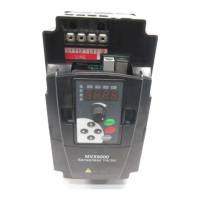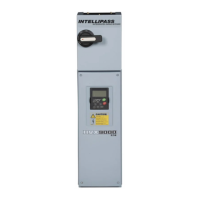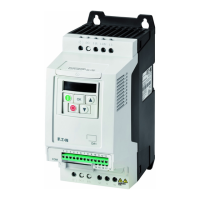Engineering
20 M-Max Series Adjustable Frequency Drive MN04020003E—October 2013 www.eaton.com
Voltage Balance
Because of the uneven loading on the conductor, and with
the direct connection of greater power ratings, deviations
from the ideal voltage form and asymmetrical voltages can
be caused in three-phase AC power networks. These
asymmetric divergences in the input voltage can lead to
different loading of the diodes in input rectifiers with
three-phase supplied frequency inverters, and as a result,
an advance failure of this diode.
In the project planning for the connection of three-phase
supplied frequency inverters (MMX32, MMX34, MMX35),
consider only AC power networks that handle permitted
asymmetric divergences in the input voltage +3%.
If this condition is not fulfilled, or symmetry at the connection
location is not known, the use of an assigned main choke is
recommended.
Total Harmonic Distortion (THD)
The THD (Total Harmonic Distortion) is a measurement for
the occurring harmonic distortion of the sinusoidal oscillation
(input power side) input variables with the frequency
inverter. It is given in percent of the total value.
U
1
= fundamental component
THD k = 0.1 K = 10% ~ –20 dB (THD suppression)
With M-Max series frequency inverters, the permitted value
for the total harmonic distortion THD is >120%.
Idle Power Compensation Devices
Compensation on the power supply side is not required for
M-Max series frequency inverters. From the AC power
supply network, they take on very little reactive power of the
fundamental harmonics (cos ~ 0.98).
In the AC power networks with non-choked idle current
compensation devices, current deviations can enable parallel
resonance and undefinable circumstances.
In the project planning for the connection of frequency
inverters to AC power networks with undefined
circumstances, consider using main chokes.
Input Reactors
A input reactor (also called commutation inductor) increases
the inductance of the power supply line. This extends the
current flow period and dampens input deviations.
On frequency inverters, a input reactor limits the input
feedback to permissible values. The harmonic current
emissions that are fed back into the input network (“input
feedback”) are reduced. This reduces the input-side apparent
current to about 30%.
Toward the frequency inverter, the input reactors dampen
the interference from the supply network. This increases the
withstand voltage of the frequency inverter and lengthens
the lifespan (diodes of the input power rectifier, intermediate
circuit capacitors).
For the operation of the M-Max frequency inverter, the
application of main chokes is not necessary.
We do recommend, however, that an upstream main choke
is used because the network quality is not known in most
cases.
While planning the project, consider that a input reactor is
only assigned to a single frequency inverter for isolation.
Using a large input reactor for multiple small frequency
inverters should therefore be avoided if at all possible.
When using an adapting transformer (assigned to a single
frequency inverter), a main choke is not necessary.
Input reactors are designed based on the input current (I
LN
)
of the frequency inverter. Input chokes and the assignment
to M-Max frequency inverters are explained in the appendix.
K
U
2
2
U+
3
2
U
4
2
... U
n
++
2
+
U
1
2
U+
2
2
U
3
2
U
4
2
... U
n
++
2
++
-----------------------------------------------------------------------------------------------------------
=
•
100%
THD
U
2
2
U+
3
2
U
4
2
... U
n
++
2
+
U
1
----------------------------------------------------------------------------------------------------=

